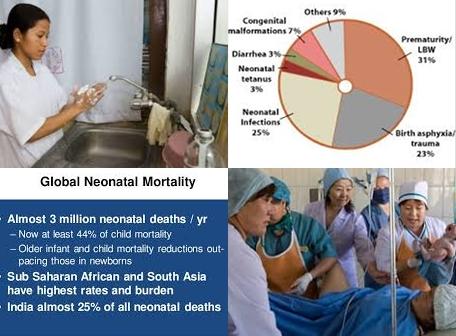
Objectives:
The World Health Organization recommends participatory learning and action (PLA) in women’s groups to improve maternal and newborn health, particularly in rural settings with low access to health services. There have been calls to understand the pathways through which this community intervention may affect neonatal mortality. Therefore, this review article (meta-analysis) has been conducted.
The aim of this review article is to examine the effect of women’s groups on key antenatal, delivery and postnatal behaviours in order to understand pathways to mortality reduction.
Study design:
This review article included data from 7 cluster-randomised controlled trials that took place between 2001 and 2012 in rural India (2 trials), urban India (1 trial), rural Bangladesh (2 trials), rural Nepal (1 trial) and rural Malawi (1 trial), with the number of participants ranging between 6,125 and 29,901 live births.
There is a high degree of heterogeneity for effects on most behaviours, possibly due to the limited number of trials involving women’s groups and context-specific effects.
Results and conclusions:
The investigators found overall, women’s groups practising participatory learning and action significantly improved behaviours during and after home deliveries, including:
-the use of safe delivery kits [during: OR = 2.92, 95% CI = 2.02-4.22, I2 = 63.7% and after: 95% CI = 4.4%-86.2%];
-the use of a sterile blade to cut the umbilical cord [during: OR = 1.88, 95% CI = 1.25-2.82, I2 = 67.6% and after 95% CI = 16.1%-87.5%];
-birth attendant washing hands prior to delivery [during: OR = 1.87, 95% CI = 1.19-2.95, I2 = 79% and after: 95% CI = 53.8%-90.4%];
-delayed bathing of the newborn for at least 24 hours [during: OR = 1.47, 95% CI = 1.09-1.99, I2 = 68.0% and after 29.2%-85.6%] and;
-wrapping the newborn within 10 minutes of delivery [during: OR = 1.27, 95% CI = 1.02-1.60, I2 = 0.0% and after: 95% CI = 0%-79.2%]. Significant because RR of 1 was not found in the 95% CI of 1.02 to 1.60. RR of 1 means no risk/association.
Effects were partly dependent on the proportion of pregnant women attending groups.
The investigators found overall, women’s groups practising participatory learning and action non-significantly improved behaviours during and after home deliveries, for:
-uptake of antenatal care [during: OR = 1.03, 95% CI = 0.77-1.38, I2 = 86.3% and after: 95% CI = 73.8%-92.8%];
-facility delivery [during: OR = 1.02, 95% CI = 0.93-1.12, I2 = 21.4% and after: 95% CI = 0%-65.8%];
-initiating breastfeeding within 1 hour [during OR = 1.08, 95% CI = 0.85-1.39, I2 = 76.6% and after: 95% CI = 50.9%-88.8%] or;
-exclusive breastfeeding for 6 weeks after delivery [during OR = 1.18, 95% CI = 0.93-1.48, I2 = 72.9% and after: 95% CI = 37.8%-88.2%]. Non-significantly because RR of 1 was found in the 95% CI of 0.93 to 1.48. RR of 1 means no risk/association.
The investigators concluded that women’s groups practising participatory learning and action improve key behaviours on the pathway to neonatal mortality, with the strongest evidence for home care behaviours and practices during home deliveries. A lack of consistency in improved behaviours across all trials may reflect differences in local priorities, capabilities and the responsiveness of health services. Future research could address the mechanisms behind how participatory learning and action improves survival, in order to adapt this method to improve maternal and newborn health in different contexts, as well as improve other outcomes across the continuum of care for women, children and adolescents.
Original title:
Effects of women’s groups practising participatory learning and action on preventive and care-seeking behaviours to reduce neonatal mortality: A meta-analysis of cluster-randomised trials by Seward N, Neuman M, […], Prost A.
Link:
http://journals.plos.org/plosmedicine/article?id=10.1371/journal.pmed.1002467
Additional information of El Mondo:
Find more information/studies on food fortification/malnutrition, pregnancy and study design/meta-analysis/significant right here.